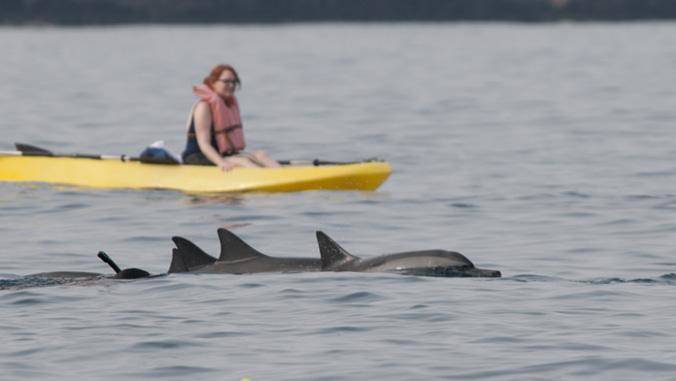The Hawaii County Council is urging the federal government to implement rules to prohibit close contact between humans and Hawaiian spinner dolphins.
At a meeting Wednesday, the council voted to support a resolution requesting that the National Oceanic and Atmospheric Administration ratify a proposed rule that would protect Hawaiian spinner dolphins — a subspecies of dolphin commonly found in the waters surrounding the Hawaiian Islands, also called a nai‘a — from being harassed or disturbed.
“This has been in discussion since 1992,” said Krista Johnson, a member of Hawaii marine conservation organization Kai Kuleana. “It’s really just about getting it more clear because ‘harassment’ is a really loose word.”
Under the proposed rule, people would be prohibited from approaching within 50 yards of a Hawaiian spinner dolphin or be subject to penalties. Johnson said the prohibition is similar to NOAA’s current regulations surrounding whales, whereby people are prohibited from approaching within 100 yards of a whale or else face severe fines.
Violators of the NOAA’s Marine Mammal Protection Act could face penalties of up to an $11,000 fine, one year in prison and forfeiture of any vessel involved.
But Johnson said that, because of the nebulous definition of “harassment,” some tour operators that promote dolphin viewing are able to significantly disrupt dolphin populations without consequence. Some operators, she said, use several vessels to effectively blockade a bay, preventing dolphins from leaving, or repeatedly “leapfrog” a traveling pod of dolphins, with a boat overtaking the pod to deposit swimmers in its path.
“Imagine 15 boats leapfrogging a pod like that. It’s this melee of total idiocy,” Johnson said. “These dolphins are already under extreme stress because of climate change and warmer waters.”
The rule notes a growing body of scientific evidence indicating that such activities are having long-term effects on the dolphins’ behavior.
For example, most dolphin-watching activities take place during the daytime, when the dolphins are resting in preparation for their nightly foraging. With their rest disturbed by humans, dolphins are increasingly avoiding areas where they would typically rest in order to avoid humans, or are resting less when humans are present, marine biologists have observed.
In the longer term, disruptions to the dolphins’ behaviors could lead to habitat displacement or reduced reproductive success, the proposed rule warns.
Although Johnson said some tour operators claim they would lose business if they weren’t able to conduct dolphin viewing activities as they see fit, she added that other operators do follow NOAA guidelines and still turn a profit.
“There’s this Disneyland mentality that’s coming from places like Florida or California or Washington, D.C.” Johnson said. “There’s this mentality that ‘nobody said no, so we’re just going to do it.’”
Johnson added in a letter submitted to the Council on behalf of Kai Kuleana “that there is no Hawaiian indigenous cultural nor religious practice, past or present, that allows or encourages interactions between humans and nai‘a that involves touching, swimming with or alongside, following, or pursuing these animals.
“The only occasion where direct interaction may be appropriate is when a recognized cultural practitioner, working with federal and state agency partners, assists with a stranding or responds to a potential injury or death of a protected marine species, following strict cultural protocols,” the letter went on.
Council chair Maile David said the resolution was a “desperate measure” to convince NOAA to take action on the proposed rule which hasn’t moved since 2016.
“The time to publish it is now,” David said, adding that, upon the measure’s passage — it passed unanimously — she would pass it along to the state’s congressional delegation for additional support.
Johnson speculated that NOAA had delayed action in order to wait for a more receptive federal administration. With the new administration inaugurated this year, Johnson said there is “nothing stopping them from passing it at this point.”
However, Johnson added that a Hawaii County Council throwing its support behind the rule could be enough to finally get it passed.
The rule might also lend momentum to similar proposals protecting manta rays and sharks from harassment, she said.
Email Michael Brestovansky at mbrestovansky@hawaiitribune-herald.com.

